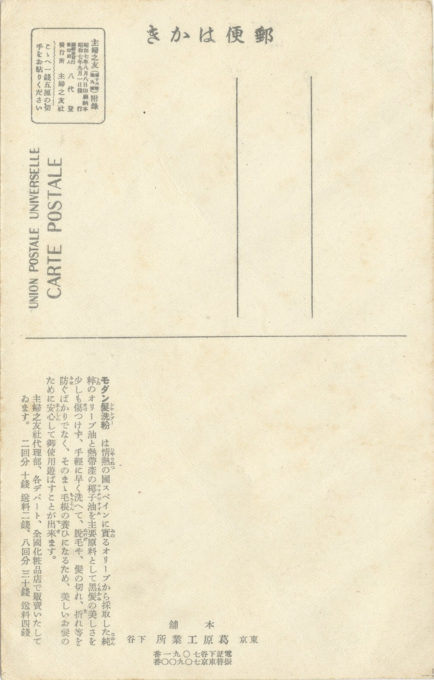
“Modern Shampoo” advertising postcard, c. 1935. “Wash your hair – and wash it with ease – no matter how much hair you have. [Endorsed by] the famous Tanaka Kinuyo of Shochiku [movie studio] and patron of Modern Hair Washing Cake Shop.” Also pictured in front of the “Modern Shampoo Bookstore”, located near present-day Shinagawa, Tokyo, are a 1930 Ford Model A 4-door sedan and an early-1930s Harley-Davidson motorcycle.
Tanaka had a film career lasting over 50 years with more than 250 credited films (including the lead role in Japan’s first feature-length “talkie” in 1931), best-known for her roles in collaboration with director Kenji Mizoguchi in over 15 films between 1940 and 1954. In 1953, Tanaka became only the second woman ever in Japan to direct a film, Love Letter, which was entered as a contestant into the 1954 Cannes Film Festival.
See also:
Hair fashion, c. 1910.
Changing fashion (“Shampoo Coiffure”), c. 1910.
Changing fashion (Western dress), c. 1910.
“When Nagase Tomiro opened his first Western sundries shop in Tokyo in 1887, cosmetic soap used for the face and body was not commonly seen in the average Japanese household, and in Japan neither hand washing nor hair washing was the general custom that each is today.”
“Historically, the oldest ‘shampoo’ [in Japan] is said to be the water left over after washing rice. The original ‘shampoo soap’ was first introduced by Kao in 1932 … the first company in Japan to sell a product under the name ‘shampoo’ [シャンプー].
“It was called shampoo, but it looked like a bar of soap. [laughter] You could break it into powder and mix it with water to create lather. Compared to what the people had been using to wash their body and hair, just the fact that this soap was specifically for the hair caught people’s attention. It lathered up well and smelled lovely, so the difference in the end result was night and day. From what I understand, it became well-known among the wealthy, then spread from there.”
– “‘From Baby’s First Bath’: Kaō Soap and Modern Japanese Commercial Design”, by Gennifer Weisenfeld, The Art Bulletin, Sept. 2004

“Modern shampoo”, postcard reverse, c. 1935. Translation to the left.
[Translation from the back of the postcard:]
“Modern Hair Washing Powder is made from pure olive oil, from the passionate country of Spain, and heat-balanced coriander oil which can be used to wash hair lightly and quickly without damaging the beauty of your hair. Not only does it prevent the hair from breaking but it also nourishes the hair roots, so you can use with confidence and peace of mind.
“It is sold at Shufu-no-tomosha‘s bookstore, department stores, and national cosmetic stores.”
Modern Shampoo Bookstore – Tokyo Kuzuhara [Shinagawa] Industrial Park
Note: Shufu-no-tomo [“Housewife’s Friend”] was a women’s magazine, first published in 1917 by Ishikawa Takemi, that would go on to become Japan’s largest-selling pre-war women’s lifestyle magazine.

